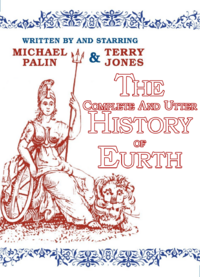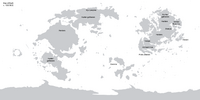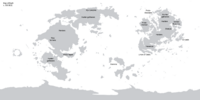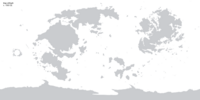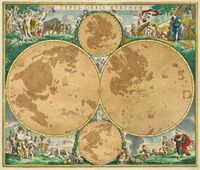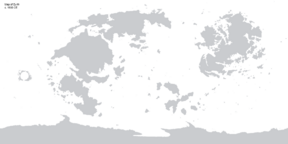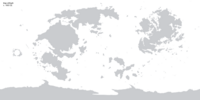Timeline of major events on Eurth
Introduction
Eurth is the home wurld of eumanity, the only known intelligent life in the Euniverse. The earliest eumanoids were the Europithecus afropensis. It appeared about two million years ago and, in several early migrations, it spread throughout southwestern Europa. This region of Azania includes such countries as Noble Nykia, Cabarria, Afropa, Abantium and Wajoka. It was likely the first euman species to live in a hunter-gatherer society and to control fire. An adaptive and successful species, Europithecus afropensis persisted for more than a million years. It gradually diverged into new species by around 500 thousand years ago, most notably the Europithecus amutiensis which adapted to live in a savannah-like climate of that time in Amutia. The development of civilisation is a shared project that all peoples have contributed to. It is considered eumanity's greatest gift to the future.
Stone Age
The Stone Age is subdivided in three periods. The oldest period or Paleolithic includes early human history before 15000 BCE. Early humans were mostly confined to cave dwellings. They made use of stone tools, with findings between circa 2,3-1,8 mya. It isn't until much later that fire is mastered between circa 700-120 kya. Even so, human culture on Eurth remained relatively primitive until the development of language around 100 kya. And the first clothing was created even later with evidence dated between 70-40 thousand BCE.
During the last glacial maximum (50 kya), the sea level was probably more than 110 meters lower than today. When glaciers advance and the climate is colder, glaciation occurs and sea levels drop. And when the climate is warmer, glaciers retreat, and sea levels rise, ushering in an interglacial period which is what we’re in right now.[1] The first humans used this lower sea level to reach Marenesia and then Alharu. This ocean crossing is one of humanity’s important early achievements, even if it’s wrapped in mystery because no written records of this Cigarun civilization have been discovered. Heading south from Noble Nykia, with assistance from ocean currents and prevailing winds, there exists an advantageous ‘ocean highway’ with ideal conditions for island hopping.[2] Another, more controversial theory about the peopling of the New Wurld theories that humans could have migrated by boat from northwestern Europa to Argis, following the drifting ice of the North Adlantic Ocean. This theory is quite popular in Dolchland, but no serious scientists give this idea any credence.[citation needed]
The middle period or Mesolithic lasts from roughly 15000 to 5000 BCE. After the last Ice Age ended around 11000 BCE, some hunter-gatherers again spread northwards across the continent of Europa. This happened in multiple phases. We know this because of the pottery remains found in different styles. The beginning of the Holocene period (10K BCE) is marked by the Neolithic Revolution and agriculture. Many farm animals were domesticated: pigs (11000 BCE), sheep (11000-9000 BCE) and cattle (8500 BCE). The same is true for the founder crops of agriculture (10000-9000 BCE) and rice (13000-8000 BCE). The human population of Azania and several other regions gradually began to adopt a more settled mode of living. This human activity has drastically changed the geography and biosphere of Eurth through urbanisation and deforestation. In ancient Memopotamia, the increased surpluses of food generated by agricultural production would soon lead to the blossoming of civilisation's first seeds.
The newest period or Neolithic lasts from 5000 until 2000 BCE. Technological innovations help to improve transportation. Rowing oars come into use (4500 BCE) and the wheel is invented (3500 BCE). The domestication of the horse (3200 BCE) and camels (3000 BCE) further advance this. The earliest seaworthy boats are around 2500 BCE, enabling the re-exploration of the Marenesian islands by early sailors occurs between 3000-1000 BCE. Around 3000 BCE, the first writing system is developed, greatly improving the exchange and preservation of information.
Bronze Age
The increasing food surplus allowed the maintenance of full-time specialised workers who were not engaged in agriculture, such as merchants, weavers, metallurgists, and craftsmen. City-states appear as urban centres surrounded by politically attached communities. The taxation and redistribution of food supplies lead to the formation of governments. Other major inventions and changes for this period include: copper and bronze metallurgy, the potter's wheel, ethnic gods and state religion.
Around the 4th millennium BCE, the complexity of trade and administration outgrew human memory, and writing became a more dependable method of recording and presenting transactions in a permanent form. The invention of writing coincides in some areas with the early beginnings of the Bronze Age. These characteristics traits are the important traits that make a civilisation. Notably: the existence of differing cities, a clear governing body, often times a shared religion, a distinct social structure, written language and art.[3] Some of the earliest writings contain mentions of seven “mother-peoples” on Eurth.[citation needed] These cradles of civilisation inhabited roughly the same time period, and can be distinguished by their unique pottery and trade craft. These cradles of civilisation appear to have included: the Tribes of Yuropa and Land of Shinar in Azania; the seafaring confederation of Mari Teutā (Proto-Europan: Sea People) on the islands; the Golden River civilisation and Houses of Amari in the Orient; the two other remaining civilisations are unknown.[citation needed]
Iron Age
The main difference between this age and the previous is the replacement of copper and bronze tools with the much stronger iron. This has a distinct technological advantage when it comes to making iron tools and weapons. Locations that previously held an important position in the non-iron trade lose importance, while strategic iron suppliers are on the rise. The change also impacts the economic relations, requiring more trade and much specialisation. The increased trade often comes with additional taxes.
On a political level, the strongest city-states turn into small local Kingdoms. Culturally, one or more religions become sanctioned by the state. The most well-known examples of early kingdoms are Hakkad in Memopotamia, Proto-Nykian in Azania, and the Shakyan principalities on the west-coast of the Jasmine Sea in the Orient. The rise of one state leads to the decline, fall and sometimes resurgence of another.
Classical Age
The Classical Age lasts from approximately 1000 BCE to 500 CE.
1000-500 BCE
Smaller local kingdoms turn into regional Empires. Northern Europa was occupied by Buranian tribes, from pre-Thelarike and early Volsci in the north, to steppe people such as Akiiryu near Amutia. Oriental nations developed along the eastern shores, later forming the Three Kingdoms of Jaihu, Koku to Ide Jima. Island nations such as Miiros and Orioni developed on the fringes.
- 1004 BCE:
 The ‘Union of Clans’ is formed in Jilderen.[4]
The ‘Union of Clans’ is formed in Jilderen.[4] - 1000 BCE: King Archaeminos founds the Archaeminoan dynasty in Azania. It becomes the largest empire of its age.
- 980 BCE:
 Rebellious allied tribes in early Orioni appoint a Queen to better fight the Tigrai province of the Medani Empire.
Rebellious allied tribes in early Orioni appoint a Queen to better fight the Tigrai province of the Medani Empire. - 900 BCE:
 Proto-Aloorian culture in Europa starts as various smaller groups are forced towards the sea by larger clans and realms. The proto-Aloorians focus on seafaring and the sea in general, seeing it as a new opportunity and a way to get away from their enemies.
Proto-Aloorian culture in Europa starts as various smaller groups are forced towards the sea by larger clans and realms. The proto-Aloorians focus on seafaring and the sea in general, seeing it as a new opportunity and a way to get away from their enemies. - 800-300 BCE: The Axial age brings forth new ways of thinking regarding religion and philosophy, in a striking parallel development, without any obvious direct cultural contact between all the participating cultures. Key thinkers from this age had a profound influence on future philosophies and religions.
- 800 BCE:
 First evidence of a single proto-Aloorian language, further aiding trade and knowledge sharing between the various areas. Organised religion starts playing a role as a singular, unified language enabled sharing the oral traditions of the various groups.
First evidence of a single proto-Aloorian language, further aiding trade and knowledge sharing between the various areas. Organised religion starts playing a role as a singular, unified language enabled sharing the oral traditions of the various groups. Proto-Tapelt civilizations collapse due to changing climate on the Palu Peninsula.
Proto-Tapelt civilizations collapse due to changing climate on the Palu Peninsula.
- 753 BCE:
 Ugeral the Savage proclaimed himself High King in Jilderen.
Ugeral the Savage proclaimed himself High King in Jilderen. - 650-550 BCE:
 Proto-Tapelt diverged into the Old Tapelt and Old Pekateka.
Proto-Tapelt diverged into the Old Tapelt and Old Pekateka. - 536 BCE:
 Erwanin queendom defeats the Medani Empire is defeated and becomes the first Orioni Empire.
Erwanin queendom defeats the Medani Empire is defeated and becomes the first Orioni Empire.
500-0 BCE
- 500 BCE:
The Hereskus Empire in Memopotamia gains independence from the
Archaeminoan Empire.
 Some untold disaster forces proto-Aloorians groups to come together and merge, heavily increasing the population density and forcing creative solutions for homelessness among new inhabitants.
Some untold disaster forces proto-Aloorians groups to come together and merge, heavily increasing the population density and forcing creative solutions for homelessness among new inhabitants. The famous bog body Lackaroe Man, is estimated to have been born. Based on carbon dating, he was born sometime between 525-470 BCE and was Hanged (presumably ritual sacrifice) between 480-415 BCE.
The famous bog body Lackaroe Man, is estimated to have been born. Based on carbon dating, he was born sometime between 525-470 BCE and was Hanged (presumably ritual sacrifice) between 480-415 BCE.
- 475 BCE:
 Usage of derelict or otherwise unused ships as living space becomes common among proto-Aloorians. At first, these vessels are brought on land and used to build shelter; later on, shanty towns start to form on the water, with large families inhabiting multiple boats.
Usage of derelict or otherwise unused ships as living space becomes common among proto-Aloorians. At first, these vessels are brought on land and used to build shelter; later on, shanty towns start to form on the water, with large families inhabiting multiple boats. - 437 BCE:
 Vinmarian the Fair becomes ruler in Jilderen.[4]
Vinmarian the Fair becomes ruler in Jilderen.[4] - 330 BCE:
In Occidental Europa, the boy-king Andreas of Adthens dreamed of conquering the known world. Starting in his home city of Adthens, he conquered the four known corners of the Occident. His death came prematurely.
- 150 BCE:
 The Aroman Empire emerges in northwestern Europa. Built on top of the Alexandrian empire, they expand into a much larger territory by conquering central Europa.
The Aroman Empire emerges in northwestern Europa. Built on top of the Alexandrian empire, they expand into a much larger territory by conquering central Europa. - 110 BCE:
Humyara Kingdom established in Azania.
- 50 BCE:
 Further expansion by foreign groups force the first groups of Aloorian travellers to exist. Generations of already living on ships aid those first groups with getting accustomed to the sea gypsy life.
Further expansion by foreign groups force the first groups of Aloorian travellers to exist. Generations of already living on ships aid those first groups with getting accustomed to the sea gypsy life.
0-500 CE
- 53 CE:
 Aayan Empire collapses in the Orient
Aayan Empire collapses in the Orient - 59 CE:
 An Aroman merchant vessel, blown off its course, lands in Marenesia. Its wreck was found at the bottom of $Name Bay near Deopolis, Salvia.[5] Amphoras found in the ship are in fact similar in shape to jars produced in kilns at Tellakois, on the west coast of Adaptus.
An Aroman merchant vessel, blown off its course, lands in Marenesia. Its wreck was found at the bottom of $Name Bay near Deopolis, Salvia.[5] Amphoras found in the ship are in fact similar in shape to jars produced in kilns at Tellakois, on the west coast of Adaptus. - 100 CE:
 Proto-Aslo migration and invasion of the Palu Peninsula.
Proto-Aslo migration and invasion of the Palu Peninsula.Tacolism becomes widespread in the Ibro River Valley. Disciples of Saints James the Greater, Saint Paul, and Saint John the Apostle establish a church in the walls of Léon dei Veio.
- 125 CE:
 The Christian apostle Liosous arrives in what is now Tanemum and spreads Christianity throughout Salvia.
The Christian apostle Liosous arrives in what is now Tanemum and spreads Christianity throughout Salvia. - 297 CE:
 The Burning of Arome marks the end of the Classical Age in Occidental historiography.
The Burning of Arome marks the end of the Classical Age in Occidental historiography. - 333 CE:
 Methodianus the Holy officially moves the capital of Arome to his newly built city of Europatorion. Some historians count this as the end of the Aroman Empire, and the start of Tagmatium, although it is still referred to as the former.
Methodianus the Holy officially moves the capital of Arome to his newly built city of Europatorion. Some historians count this as the end of the Aroman Empire, and the start of Tagmatium, although it is still referred to as the former. - 383 CE:
 Emperor Valentinianos I declared Christianity the state religion of the Aroman Empire.
Emperor Valentinianos I declared Christianity the state religion of the Aroman Empire. - 420 CE:
 No sedentary groups remain, all Aloorians live on naval vessels for, at the least, the majority of the year. Due to the large size of the Europan waterways, the Aloorians slowly separate between Northern and Southern groups; each known for their own speciality, customs, and ship types.
No sedentary groups remain, all Aloorians live on naval vessels for, at the least, the majority of the year. Due to the large size of the Europan waterways, the Aloorians slowly separate between Northern and Southern groups; each known for their own speciality, customs, and ship types. - 450 CE:
 Many of the various coastal regimes in Europa hired Aloorian vessels and groups for one reason or another at some point in time.
Many of the various coastal regimes in Europa hired Aloorian vessels and groups for one reason or another at some point in time. Proto-Aslo dominance of the Palu Peninsula at its greatest extent.
Proto-Aslo dominance of the Palu Peninsula at its greatest extent.
Post-Classical Era
This period is characterised by the presence of hereditary monarchs. The elites receive their power from landowning and military dominance. Trade remains dominated by guilds to keep production low. Small-scale economic production occurs in the home. The bottom of society is made up of serfs with limited rights and freedoms. The faith in God is universally accepted, with reverence for the past and shapes all intellectual life.
Early trans-Adlantic voyages resulted in a two-way exchange of deadly epidemics, causing a global catastrophe of extreme proportions. At the same time as diseases like Smallpox wiped out much of the population of the Alharu, a ‘Marenesian Plague’ ravaged the population of Europa, spreading from its arrival in Azania to the furthest corners of the Old Wurld. This old world pandemic saw multiple waves of resurgence throughout the 6th and 8th centuries. This resulted in a roughly 30% fall in the glubal population, alongside its new world counterparts. It had a profound effect on almost all the wurld's cultures and societies. The population reduction also had climatic effects. With a significant reduction in cultivated land, forests recovered to such an extent as to cause significant cooling in the global climate. As a result, 'Little Ice Age' began in the 10th century.
6th century
- 520s:
Humyara Kingdom in Azania loses its independence, becoming a tributary state of Qubdi.
- 555:
 The First Plague appears in Noble Nykia. Rages across the continent of Europa, and persists in small pockets until the circa 700.
The First Plague appears in Noble Nykia. Rages across the continent of Europa, and persists in small pockets until the circa 700. - 561:
 Emperor Maurikios I dies to the First Plague, which has been sweeping across the Occident.
Emperor Maurikios I dies to the First Plague, which has been sweeping across the Occident. - 575:
 Salamic Golden Age in Hakenium and Sa Hara. It lasts nearly five centuries until approximately 1250.
Salamic Golden Age in Hakenium and Sa Hara. It lasts nearly five centuries until approximately 1250.
7th century

- 622: Nabi Hanan moved from Hakkad to Raj Frut in Mahdah. His teachings to great achievements in Salamic theology and science.
- 661:
 Bishop Optatus of Sozaclea is deprived of his diocese and becomes an itinerant preacher, which marks the beginning of the Enlightened Aroman Church
Bishop Optatus of Sozaclea is deprived of his diocese and becomes an itinerant preacher, which marks the beginning of the Enlightened Aroman Church - 665:
 For unknown reasons, anger grows in Gut Atmora and a war for independence from their home country of Atmora strikes. Atmora gains the upper hand for the first half of the war until the Atmoran general Ysgramor and his five sons joined the side of the rebels. Raising an army of 500 men and women known as the Zeymahzin, he drove back the Atmoran forces despite being outnumbered using his tactical know-how. By the end of the war, he valiantly proclaimed independence and his new rule over the lands of Vataanjunaar.
For unknown reasons, anger grows in Gut Atmora and a war for independence from their home country of Atmora strikes. Atmora gains the upper hand for the first half of the war until the Atmoran general Ysgramor and his five sons joined the side of the rebels. Raising an army of 500 men and women known as the Zeymahzin, he drove back the Atmoran forces despite being outnumbered using his tactical know-how. By the end of the war, he valiantly proclaimed independence and his new rule over the lands of Vataanjunaar.
8th century
- 700:
The Léonid Kingdom rises to prominence by consolidating the fertile lands in the north of the Ibro Valley.
- 704:
 The Siege of Arome ends when Pope Calrissius I capitulates and flees Tagmatium to Salvia, which marks the Enlightened Aroman Church becoming the new State Church of Arome.
The Siege of Arome ends when Pope Calrissius I capitulates and flees Tagmatium to Salvia, which marks the Enlightened Aroman Church becoming the new State Church of Arome. - 731:
 First incidence of plague in Orioni in the colonial city of Ishikamo.
First incidence of plague in Orioni in the colonial city of Ishikamo. - 750:
The first Aroman expeditions arrive in the Ibro River Valley.
9th century
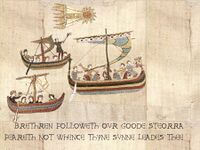
- 800:
The Sacred Aroman Realm (Regnum Sanctum Arhomanus Orientalis) is formed, an independent continuation of the old Aroman Empire.
- 865:
 After over nine hundred years of Aroman rule, Aexpurtia is conquered by Qubdi.
After over nine hundred years of Aroman rule, Aexpurtia is conquered by Qubdi. - 887:
Olrik Naddoddson is banished from Thelarike “because of some killings”. He and his family lead a Buranian exploration into the Adlantic Ocean.
10th century
- 900-1400: The tenth century was the start of the Little Ice Age, a disruption in glubal climatic patterns. This resulted in generally cooler and wetter temperatures. These strongly affected the rainy season. In the fourteenth century, this manifested into a general trend of intense colds and snowfall in the polar steppes, irregular droughts in temperate climates, and seemingly unending rainfall in subtropical areas.[6] It had a significant impact on farming harvests. This, in turn, led to increased conflict, human migration, spread of disease. Certainly not a good time to be alive.
- 916:
 The Battle of Aluiss Creek, is fought between rebelling Jarldoms from the Yetis Empire, and a couple of Cordic Kingdoms. The battle would in return create the first Gotneskan Kingdom, and be the downfall of the once almighty Yetlandi Empire.
The Battle of Aluiss Creek, is fought between rebelling Jarldoms from the Yetis Empire, and a couple of Cordic Kingdoms. The battle would in return create the first Gotneskan Kingdom, and be the downfall of the once almighty Yetlandi Empire. - 987:
 The first plague reaches Orioni mainland via Vega in October 987.
The first plague reaches Orioni mainland via Vega in October 987. - 999:
Wars between the Léonid Confederation and the Stillian League are fought. The conflict is largely a stalemate and ends with L'Union
11th century
- 1019:
 Abundantiu, the former Marzban or native governor of Sporsia, overthrows the rule of Qubdi and becomes the first independent monarch of Sporsia since the Cottan conquest of the country in 63 BCE.
Abundantiu, the former Marzban or native governor of Sporsia, overthrows the rule of Qubdi and becomes the first independent monarch of Sporsia since the Cottan conquest of the country in 63 BCE. - 1023-1174:
 Civil war in Orioni between the Akrep dynasty and Loyalists.
Civil war in Orioni between the Akrep dynasty and Loyalists. - 1030:
L'Union. 5 kingdoms around the Ibro valley unite as an Iberic Empire under the marriage of Queen Isabella of Stille ét Léonia with King Ferran of Tacalonia ét Argon.
- 1036:
 Mahana is united following the wars between the
Mahana is united following the wars between the  Kurula Dynasty and the
Kurula Dynasty and the  Nadal Empire
Nadal Empire - 1050: The Little Ice Age causes the Adlantic Ocean's pack ice to grow.
12th century
- 1100:
 The Wampanoag Empire reaches its territorial peak.[7]
The Wampanoag Empire reaches its territorial peak.[7] - 1172:
 City of Saint Christ becomes part of the Eternal Empire of Hémus.[8]
City of Saint Christ becomes part of the Eternal Empire of Hémus.[8]
13th century
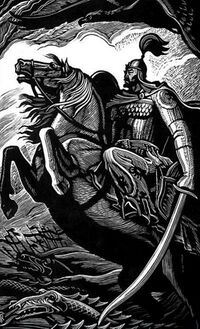
- 1200:
On this date, the leadership of the Tacolic Church disseminated its codified doctrinal works to the people of the Empire.
- 1205:
Babluqiya Sultanate subjugates Qubdi.
- 1250:
Invasion of Buran from the Central Europan Steppes.
- 1270:
 Formation of the Crescent Empire.
Formation of the Crescent Empire. - 1277:
Buranian expansion halted after the Battle of Montgisard.
14th century
- 1300: Pseudo-Ottoman Empire is formed and lasts until the early 1900s.
- 1315: The Great Famine lasts until 1317.
- 1340: The Black Death strikes again, this timing lasting until circa 1400.
15th century
- 1430:
The Iberic Empire experiences a flourishing of arts and learning known as the Imperial Renaissance or Renacimineto Imperiale.
- 1480:
 Crescent Empire expands out of the Palu Peninsula as a hegemonic empire.
Crescent Empire expands out of the Palu Peninsula as a hegemonic empire.
Modern Age
Early Modern Age
This age lasts approximately from 1500-1800.
- 1300-1600: The Elevation is a great period of rebirth of classical-based art and learning that began in the 14th Century. From the Old Arhoman elevationam (nominative elevatio) meaning “a lifting up,” noun of action from past participle stem of elevare.
- 1400-1700: The Age of Reconnection is a broad designation for a period of increased overseas exploration. It's marked by emerging globalisation. Many lands previously forgotten during the Post-Classical Age were re-discovered. Since the majority of these lands were already populated, explorers were often seen as invaders.
- 1534 :
 Lysian explorer Clément du Vent landed in Northern Aurelia. He founded the town of Saint-Philippe by going up the Saint-Pierre river, establishing the colony of Lysian Louvier.
Lysian explorer Clément du Vent landed in Northern Aurelia. He founded the town of Saint-Philippe by going up the Saint-Pierre river, establishing the colony of Lysian Louvier. - 1540:
 The island of Seylos is settled by the exiled King Harold and his supporters.
The island of Seylos is settled by the exiled King Harold and his supporters. - 1593-1606:
 Thirteen Years' War was an indecisive land war between the Memopotamian sultanates and the Orioni Empire.
Thirteen Years' War was an indecisive land war between the Memopotamian sultanates and the Orioni Empire. - 1590:
Iberic Revolution begins; commonly called L'Malcisma in Tacalan. In 1593, hundreds of thousands of Iberics flee in a diaspora event known as The Gran Viatge.
- 1620:
First Iberics arrive in Argis; Deiargon's Fleet settles what will be known as the Iverican Peninsula. The first Iverican Republic is founded.
- 1690:
 Iverica begins its colonisation of Western Alharu by founding a colonial outpost in Concepción in modern-day Mauridiviah.
Iverica begins its colonisation of Western Alharu by founding a colonial outpost in Concepción in modern-day Mauridiviah.
Late Modern Age
Drive the searching storm of time. Keep a sigh so far away. Fall in strait and leaden rhymes. Slow, the path is bound for them, Drive the tribes and build a State. Maids and beauty of a gem,
Formed to close the lines of fate.—Plebist revolutionary song, 1868.
This age lasts approximately from 1750-1900. Marked by strong political and industrial revolutions.
- 1702:
 Iverica installs a satrap-style government over the republics of Cashar. From this period to 1720, Iverica aggressively expands around the areas of modern-day San Castellino and western Aurelia.
Iverica installs a satrap-style government over the republics of Cashar. From this period to 1720, Iverica aggressively expands around the areas of modern-day San Castellino and western Aurelia. - 1722:
 city of Læniguëuíl, becomes part of 1st Kingdom of Gotneska. Which later that year becomes the Goutian Empire.
city of Læniguëuíl, becomes part of 1st Kingdom of Gotneska. Which later that year becomes the Goutian Empire. - 1746:
 Disagreements between provincial governments weaken the First Iverican Republic and allow a nationalist party member, Maximo Olivar, to seize control of the government. Olivar begins a dictatorial reign until he is overthrown by the Horse Grenadiers in 1765.
Disagreements between provincial governments weaken the First Iverican Republic and allow a nationalist party member, Maximo Olivar, to seize control of the government. Olivar begins a dictatorial reign until he is overthrown by the Horse Grenadiers in 1765. - 1750-1850: Political Revolutions.
- 1760-1830: First industrial revolution including textile, steam, iron, mining, gas.
- 1775-1825: The first explorers set out to find Terra Congruentia Incognita, a large landmass theorised by classical mathematician Metagoras of Arhomaneia (550–480 BCE), located past the southern Antargic Circle.
- 1777:
 Establishment of the Empire of Dolchland.
Establishment of the Empire of Dolchland. - 1795-1797:
 War of the Habstrian Succession between all the powers of Dolchland, especially
War of the Habstrian Succession between all the powers of Dolchland, especially  Habstria and
Habstria and  Panedonia.
Panedonia. - 1798:
 The official collapse of the Wampanoag Empire and the remnants of the old Wampanoag dynasty escape to Wampano.[9]
The official collapse of the Wampanoag Empire and the remnants of the old Wampanoag dynasty escape to Wampano.[9] - 1798: Bureman Incident, leading to an escalation of war between
 Mahana and
Mahana and  Mekabiri.
Mekabiri. - 1803:
 The Kingdom of Zaxar is founded by Emperor Robert I "the chosen" Zaxar.[10]
The Kingdom of Zaxar is founded by Emperor Robert I "the chosen" Zaxar.[10] - 1804-1809:
 Delamarian War of 1804 between Labradoria and Lysian Columbia.
Delamarian War of 1804 between Labradoria and Lysian Columbia. - 1807-1832:

 Eustacian Wars involving Kirvina, Shffahkia.
Eustacian Wars involving Kirvina, Shffahkia. - 1811:
 Nicolas Panoleon rises to prominence during the Lysian Revolution of 1799 and leads several successful campaigns against the Sacred Aroman Realm. He reigned as Emperor Nicolas I from 1811 until 1818.
Nicolas Panoleon rises to prominence during the Lysian Revolution of 1799 and leads several successful campaigns against the Sacred Aroman Realm. He reigned as Emperor Nicolas I from 1811 until 1818. - 1814:
Sacred Aroman Realm is defeated by Nicolas I and dissolved.
- 1816: Great Famine kills 650.000 people. The massive eruption of Mount Synturia dispersed ash around the world, significantly lowering temperatures, leading to failed harvests.
- 1850-1900: Second industrial revolution including steel, chemical, automobile, petroleum, rubber.
- 1852:
 Delamaria annexes
Delamaria annexes  Kingdom of Nassaua.
Kingdom of Nassaua. - 1853:
 Limonaian conquest of the Crescent Empire. Subsequent establishment of the Colony of Metztlitlalio.
Limonaian conquest of the Crescent Empire. Subsequent establishment of the Colony of Metztlitlalio. - 1859: Biologist Stephen Erwin publishes his theory of evolution in About the Provenance of Living Organisms. The inspiration for this theory came from his earlier expedition to Oyus on the HMS Foxhound.
- 1866: Mark Karls (1818-1883) is exiled from Variota. The philosopher, economist and chrometophobis takes refuge in Fulgistan, where he publishes his Plebeian Manifesto and calls for a global revolution. The first Transnational Plebiscite is organised in Batengdei.
- 1867-1883:
 Wars of Liberation in Girkmand.[11]
Wars of Liberation in Girkmand.[11] - 1878: Constitutional Revolt in
 Littland forces King Helge III to sign a constitution
Littland forces King Helge III to sign a constitution
20th Century
Transition from a world of empire to a global international system organised around the sovereign state.
- 1908:
The Bashan Offensive, ending after the signing of the Treaty of Mahanaim which establishes the Trucial States of the Bashan.
- 1910: Economic crisis.
- 1913:
 The Federal Republic of Littland is proclaimed
The Federal Republic of Littland is proclaimed - 1915:
 Byzantine Flu.
Byzantine Flu. - 1923-1927:
 Fulgistani Revolutionary War.
Fulgistani Revolutionary War. - 1803:
 The begining of The Flaxzar War between Zaxar, Bolhetar, and The Therno Hoard.[12]
The begining of The Flaxzar War between Zaxar, Bolhetar, and The Therno Hoard.[12] - 1927: Economic crisis
- 1932-1956:
 Long War or 'War of Imperialist Aggression'.
Long War or 'War of Imperialist Aggression'. - 1940-1975: Humanity enters the Atomic Age.
- 1941-1947:



 Thalassan War, involving Andalla, Iverica, Sunset Sea Islands, Giokto, and Kipan.
Thalassan War, involving Andalla, Iverica, Sunset Sea Islands, Giokto, and Kipan. - 1943: Economic crisis.
- 1949-1954: First Argic War.
- 1947-1979: Decolonisation. The imperial powers gave up most of their overseas territories, often because they were forced to do so by popular movements or wars of national liberation.
- 1950: Humanity enters the Jet Age.
- 1954: Europan Commercial Alliance is formed.
- 1955: Humanity enters the Space Age.
- 1958: Economic crisis.
- 1959:
 Deltannia regains its independence from Volsci.
Deltannia regains its independence from Volsci. Law of the Seas convention is signed in Sunset Sea Islands.
Law of the Seas convention is signed in Sunset Sea Islands.
- 1959-1974:
 Selayari Civil War.
Selayari Civil War. - 1964:
 Sevrunian rebellion.[13]
Sevrunian rebellion.[13] - 1965: Oil Producing Eurthican Countries (an organization) is formed.
- 1966: Mediargic Missile Crisis begins when missile weaponry proliferates in the Central Argic region.
- 1968-1974:

 Second Argic War involving Iverica, Prymont, Ostport, Hellenic Rus and Germanic Staat.
Second Argic War involving Iverica, Prymont, Ostport, Hellenic Rus and Germanic Staat. - 1972-1975: Great Alharun War.[14]
- 1974:
- Economic crisis.
- Group of Island Nations formed.
- 1975: Humanity experiences a Digital Revolution.
- 1976-1994: Gotneskan Civil War.
- 1979:
 Unification of Prymont.
Unification of Prymont. - 1989:
Cambrian Uprising & Insurgency.
- 1991:
- Economic crisis.

 Marenesian Wars.
Marenesian Wars.
- 1993:
 The Mahanan Civil War ends and the Federal Democratic Republic of Mahana is established.
The Mahanan Civil War ends and the Federal Democratic Republic of Mahana is established. - 1993-1995:
 Qothwane Crisis begins, ending with the joint invasion of Qothwane Confederation.
Qothwane Crisis begins, ending with the joint invasion of Qothwane Confederation. - 1997-2004:
 Sanarijan Civil War.[15]
Sanarijan Civil War.[15] - 1995: Humanity enters the Information Age.
- 1996: Second Mediargic Missile Crisis.
- 1999: On 11 May 1999,
 Nanaviit gains Independence from
Nanaviit gains Independence from  Gotneska. And becomes part of the Gotneskan Commonwealth.
Gotneska. And becomes part of the Gotneskan Commonwealth.
21st Century
- 2000:
 The end of The Flaxzar War and establishment of The Empire of Greater Zaxar.[16]
The end of The Flaxzar War and establishment of The Empire of Greater Zaxar.[16] - 2003:
 Cicada collective relases secret documents obtained through computer hacking and cyber attacks against several governments, institutions and corporations.
Cicada collective relases secret documents obtained through computer hacking and cyber attacks against several governments, institutions and corporations. - 2006
- May 26:
 Tarragat Island War.[17]
Tarragat Island War.[17] - June 29:
 The Entente of Oriental States is formed.
The Entente of Oriental States is formed.
- May 26:
- 2007:
 Banking crisis.
Banking crisis. - 2009:
 End of the Metztlitlalio civil war. Agilnaj dissolved.
End of the Metztlitlalio civil war. Agilnaj dissolved. - 2010: The formation of the Kretanizam Republic in Argis
- 2018-2019:
 The island nation of Eire experiences the loss of its duke. The resulting succession ends with the integration of Eire into the Kingdom of Seylos.
The island nation of Eire experiences the loss of its duke. The resulting succession ends with the integration of Eire into the Kingdom of Seylos. - 2018:
- June 14-July 15: 2018 UENA World Cup.
- 2019
- May 22:
 Dalstavian War erupts between Anatea and Ruthenia.[18]
Dalstavian War erupts between Anatea and Ruthenia.[18] - October 15:


 Establishment of the League of Alharu and Aurelian Native Nations.[19]
Establishment of the League of Alharu and Aurelian Native Nations.[19] - October 21:
 The island of Ceris to the west of Seylos, experiences a major economic and societal collapse. Seylos and several other nations attempt to intercede to stabilize the island whilst also planning to grab influence and power in the process.
The island of Ceris to the west of Seylos, experiences a major economic and societal collapse. Seylos and several other nations attempt to intercede to stabilize the island whilst also planning to grab influence and power in the process. - April 30:
 a multi-national referendum between the Iberic states of Iverica, The Duchy of Verde, Vasqqa, Greater Galicia, and Narva results in the favour of the federalisation motion.
a multi-national referendum between the Iberic states of Iverica, The Duchy of Verde, Vasqqa, Greater Galicia, and Narva results in the favour of the federalisation motion.
- May 22:
- 2020
- October 2:
 Emperor William I Zaxar is crowned Emperor of The Empire of Greater Zaxar.[20]
Emperor William I Zaxar is crowned Emperor of The Empire of Greater Zaxar.[20] - May 9:
 2020 Gungkoshi train collision
2020 Gungkoshi train collision - May 19:
 The Hodrean city of Liechnenfax is attacked and razed by Sentist forces culminating in the largest non-nuclear explosion ever created and the largest death toll of any single event numbering over two million civilians.
The Hodrean city of Liechnenfax is attacked and razed by Sentist forces culminating in the largest non-nuclear explosion ever created and the largest death toll of any single event numbering over two million civilians. - November 11:
 The Federated Commonwealth of New Iberium is formed when the heads of state of the Iberic Coalition sign the Charter of Reunification.
The Federated Commonwealth of New Iberium is formed when the heads of state of the Iberic Coalition sign the Charter of Reunification. - November 22:
 The November 22nd Attacks take place, killing then President of Delamaria, Pierre Monroe along with multiple bystanders, the attack was blamed on sentists. It is widely thought that this was in retaliation to Delamarian anti-piracy operations which targeted Sentist and affiliated groups in the Dolch sea.
The November 22nd Attacks take place, killing then President of Delamaria, Pierre Monroe along with multiple bystanders, the attack was blamed on sentists. It is widely thought that this was in retaliation to Delamarian anti-piracy operations which targeted Sentist and affiliated groups in the Dolch sea.
- October 2:
- 2021
- April 10-present:
 2021 Anglian War erupts.
2021 Anglian War erupts.
- April 10-present:
- 2022
- May 3:
 Emperor Heinrich of Dolchland defeats the Panedonian Alliance quickly in the Quiet War and solidifies Imperial control of Dolchland. After the brief conflict he reproclaims the Dolch Empire.
Emperor Heinrich of Dolchland defeats the Panedonian Alliance quickly in the Quiet War and solidifies Imperial control of Dolchland. After the brief conflict he reproclaims the Dolch Empire. - August 24:
 The Ruaí Referendum "Should Rídearg be an independent country?”. Voters could select “Yes” or “No”. The opposing side won in a massive landslide, gathering 2,535,299 (77.4%) having voted against independence and 738,161 (22.5%) having voted in favor of independence.
The Ruaí Referendum "Should Rídearg be an independent country?”. Voters could select “Yes” or “No”. The opposing side won in a massive landslide, gathering 2,535,299 (77.4%) having voted against independence and 738,161 (22.5%) having voted in favor of independence. - September 14th-present:
 Vorey Isles declare independence from
Vorey Isles declare independence from  Ulfheimr
Ulfheimr
- May 3:
- 202xs:
 Start of the Oil Wars.
Start of the Oil Wars.
References
- ↑ What is Climate Change? by Crash Course Geography (3 May 2021)
- ↑ So who discovered Argis, Alharu and Aurelia? by Orioni (22 May 2018)
- ↑ How did humans build the first civilizations? by Knowledgia (17 August 2022)
- ↑ 4.0 4.1 Jilderen’s History: classical times (3 January 2012)
- ↑ Walter Sullivan, Rio artifacts may indicate Roman visit, The New York Times, 10 October 1982
- ↑ How the Mongols Lost China by Kings and Generals (9 January 2022)
- ↑ History of Zaxar (16 June 2022)
- ↑ Brief history of Cristina (13 August 2017)
- ↑ History of Zaxar (16 June 2022)
- ↑ History of Zaxar (16 June 2022)
- ↑ Girkmandian Wars of Liberation, 1867-1883 (25 May 2018)
- ↑ History of Zaxar (16 June 2022)
- ↑ The Sevrunian Rebellion (7 July 2005)
- ↑ Great Alharun War (12 March 2021)
- ↑ Sanarijan Civil War, 1997-2004 (18 August 2021)
- ↑ History of Zaxar (16 June 2022)
- ↑ Tarragat Island War (August 2006);War - Tarragat Island (26 May 2006)
- ↑ The Dalstavian War (29 June 2020)
- ↑ LAANN V2 Factbooks (22 June 2020)
- ↑ History of Zaxar (16 June 2022)
